



Environmental Exposures in Schools that Interfere With Learning David O. Carpenter, MD Institute for Health and the Environment University at Albany Rensselaer, NY 12144
Chemicals Known to Cause Reduced Cognitive Function in Children Lead Methyl Mercury Arsenic Manganese Polychlorinated Biphenyls (PCBs) Polyaromatic Hydrocarbons (PAHs) Environmental Tobacco Smoke (ETS) Some Pesticides
How Are Children Exposed to these Chemicals? Ingestion from food and drinks is the most recognized route of exposure, but is not the only one. Some organic chemicals are easily absorbed through the skin. This can be important especially from personal care products. Inhalation is a major and important route of exposure. volatile chemicals that are directly absorbed in the lung. chemicals bound to particulates which are retained in the lung and then are slowly released into the blood stream. The chemicals bound to particulates can be either organics or metals.
Other Exposure that Reduce Learning Noise Poor lighting Excessive Electromagnetic Fields
Attention Deficit/Hyperactivity Disorder Childhood Hyperkinesis, or Attention-Deficit Hyperactivity Disorder (ADHD), is a behavior disorder characterized by three main, partly interrelated, symptoms; inattentiveness, overactivity, and impulsiveness. The ADHD child shows inattentiveness by attending to each stimulus for only a brief period before changing the focus of attention to something else. Two-thirds of ADHD children show comorbidity with another psychiatric illness, such as autism, dyslexia, conduct disorder or oppositional defiant disorder as well as learning disability.
Risk Factors for ADHD Being male (OR = 3.05, 95% CI = 2.30-3.98). Poor maternal diet. Maternal stress. Pre- and postnatal exposure to environmental chemicals. High maternal and paternal education are protective (OR = 0.57, 95% CI = 0.42-0.78).
Cognition in ADHD ADHD is not usually associated with large reductions in intelligence, but children with ADHD do poorly on IQ tests. The major deficit in ADHD is working memory, the ability to hold something in mind while doing something else or to use information to perform an action. Cognitive flexibility, the ability to switch attention from one thing to another, is very reduced in ADHD children. It is difficult to learn if you can’t pay attention!
Stewart PW, Lonky E, Reihman J, Pagano J, Gump BB, Darvill T (2008) The relationship between prenatal PCB exposure and intelligence (IQ) in 9-year-old children. Environ Health Perspect. 116(10):1416-22.
PCBs in Schools PCBs were manufactured in the US for many years, and in the 1950s-1970s they were used in paint, fluorescent light ballasts and as a solvent in window caulking. The PCBs volatize from paint and caulk and ballasts leak when old, resulting in high concentrations of PCBs in the air in schools built during this period. Breathing PCBs is going to result in reduced ability to learn, which is the last thing one wants to have in a school.
Eubig PA, Aguiar A, Schantz SL. Lead and PCBs as risk factors for attention deficit/hyperactivity disorder. Environ Health Perspect. 2010 Dec;118(12):1654-67
Mean +/- SE WISC-IV score per quintile of prenatal urinary DAP concentration Full-Scale IQ Bouchard MF, Chevrier J, Harley KG, et al. (2011) Prenatal exposure to organophosphate pesticides and IQ in 7-year-old children. Environ Health Perspect. 119(8):1189-95.
What are the Long-Term Consequences of Exposure to these Contaminants? Of children with ADHD, about half will show symptoms as adults. There is increasing evidence that the reduced ability to deal with frustration increases the risk of anti-social behavior throughout life. The evidence for this is strongest for lead exposure, but probably applies to the other substances that show this profile of reduced IQ and behavioral changes.
Does Early-life Exposure to Environmental Chemicals Increase Risk of Crime? Wright et al. (2008) found that an elevated child’s blood lead level at 6 years of age significantly increased risk of arrest for violent crime as a young adult (OR-1.5; 95%CI = 1.1-1.9). Nevin (2000) compared historic use of lead in gasoline to arrests for violent crime 20 years later and found significant correlation.
The Relationship Between IQ and Behavior In a meta-analysis Marcus et al. (2010) concluded that that concentrations of lead that result in decrements of IQ are the same concentrations that result in shortened attention span and anti-social behavior. While there are fewer studies with other contaminants that reduce IQ, it is likely that the same relation applies for PCBs, methyl mercury, ETS, pesticides, PFCs, phthalates and possibly many other contaminants.
Health Effects of Radiofrequency (RF) Radiation There is strong evidence that excessive, long-term use of cell phones held to the ear increases risk of brain cancer, and that children are more vulnerable that adults. Many children in schools have and use cell phones. The cancers may occur years later. Evidence is increasing that excessive exposure to the male reproductive systems results in reduced sperm counts and infertility. While this has not been studied in children, long term effects on male reproduction are likely to result from high RF exposures.
Electrohypersensitivity Some individuals, children and adults, are unusually sensitive to RF exposures, and develop headaches, dizziness, anxiety, ringing in the ears and poor focus and attention. This is a serious problem in wireless computer classrooms, where there are often 30+ wireless devices (iPADs, laptops) and an industrial-sized router. This will result is very high RF levels that will increase long- term risk of cancer and reduced fertility and subject some children to developing electrohypersensitivity.
Conclusions: Schools are places where children go to learn. Every effort should be made to eliminate all exposures in schools that will interfere with the learning process. Many of the contaminants discussed above reduce attention span. How can a child learn if he/she can’t pay attention? Exposure to RF radiation is a new threat to learning and health. We need to find ways in which a child has access to the internet and modern communication technology without adversely impacting health and ability to learn.
Recommend
More recommend